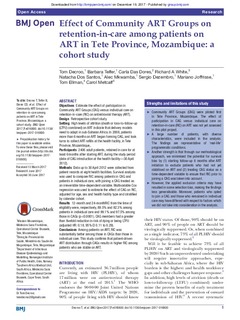| dc.description.abstract | Objectives Estimate the effect of participation in Community ART Groups (CAG) versus individual care on retention-in-care (RIC) on antiretroviral therapy (ART). Design Retrospective cohort study. Setting High levels of attrition (death or loss-to-follow-up (LTFU) combined) on ART indicate that delivery models need to adapt in sub-Saharan Africa. In 2008, patients more than 6 months on ART began forming CAG, and took turns to collect ART refills at the health facility, in Tete Province, Mozambique,. Participants 2406 adult patients, retained in care for at least 6 months after starting ART, during the study period (date of CAG introduction at the health facility-30 April 2012). Methods Data up to 30 April 2012 were collected from patient records at eight health facilities. Survival analysis was used to compare RIC among patients in CAG and patients in individual care, with joining a CAG treated as an irreversible time-dependent variable. Multivariable Cox regression was used to estimate the effect of CAG on RIC, adjusted for age, sex and health facility type and stratified by calendar cohort. Results 12-month and 24-monthRIC from the time of eligibility were, respectively, 89.5% and 82.3% among patients in individual care and 99.1% and 97.5% among those in CAGs (p<0.0001). CAG members had a greater than fivefold reduction in risk of dying or being LTFU (adjusted HR: 0.18, 95% CI 0.11 to 0.29). Conclusions Among patients on ART, RIC was substantially better among those in CAGs than those in individual care. This study confirms that patient-driven ART distribution through CAGs results in higher RIC among patients who are stable on ART | |
